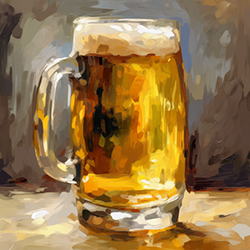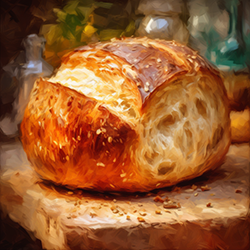Can I Use Wine Yeast for Beer, Beer Yeast for Wine or Bread Yeast for Either?
Posted by Matteo Lahm on 5th Dec 2024
When the time comes to choose your yeast, you have lots of choices. Ask what’s the best on social media and you’ll get a lot of different answers. So how do you know what to do? In the end, your selection comes down to preference however, there are limits. There are three general rules you should follow for fermenting. Use fruit yeasts for fruit, beer yeasts for grain and bread making yeast for neither. While beer, wine and bread yeasts share a common ancestor in the Saccharomyces cerevisiae species, the differences between them are like comparing a Great Dane, a Sheep Dog and a Dachshund. Like different dog breeds, the different variations of yeast have evolved to favor different pH ranges and perform different jobs. This article delves into the physiological, biochemical, and genetic factors that shape these preferences and their implications for your beer and wine.

The ancient art of brewing beer and making wine has captivated humanity for millennia, with roots tracing back to the cradles of civilization in Mesopotamia and Egypt. At the core of these processes lies the fermentation of sugars by yeasts, which give birth to alcohol. Although beer and wine production both rely on the same species, the strains employed in each process have evolved to thrive under different pH conditions. Let’s uncover the reasons behind these differences and their implications for your beer and wine.
The distinct pH preferences of beer and wine yeasts can be traced back to the unique environments in which they are cultivated. Beer wort, the nectar extracted from malted grains, typically boasts a pH range of 5.0 to 5.5, while grape must, the crushed grapes destined for winemaking, presents a pH range of 3.2 to 3.6. These differences in acidity arise from the presence of organic acids in grapes, and phosphoric acid in malted grains.

Over time, the yeasts used in beer and wine production have adapted to these environments, developing physiological mechanisms that enable them to flourish under specific pH conditions. For example, wine yeasts have evolved to withstand higher acidity levels by maintaining a more alkaline intracellular pH, which safeguards their cellular machinery from harm. In contrast, beer yeasts are better suited to the more alkaline conditions of wort, with a lower tolerance for acidic environments.
The biochemical processes unfolding during fermentation also contribute to the preferred pH ranges of beer and wine yeasts. For instance, the production of organic acids, such as acetic and succinic acids, can lower the pH of the fermentation medium. Wine yeasts are better equipped to cope with this drop in pH, as they possess more robust acid-tolerance mechanisms, including the ability to pump protons out of the cell and maintain a stable internal pH.
Moreover, the enzymes involved in the metabolic pathways of beer and wine yeasts exhibit different pH optima. For example, the enzymes responsible for converting sugars into alcohol and carbon dioxide in wine yeasts have a lower pH optimum than those in beer yeasts. This allows wine yeasts to function more efficiently under acidic conditions, while beer yeasts perform better at higher pH levels.
The genetic makeup of beer and wine yeasts also plays a role in determining their preferred pH ranges. Through selective breeding and spontaneous mutations, these strains have acquired specific genetic traits that enable them to thrive under the unique conditions of their respective fermentation environments. For instance, wine yeasts possess genes that encode for acid-tolerance proteins, which help protect the cell from the damaging effects of low pH. In contrast, beer yeasts lack these genes, making them less suited to acidic environments.

Deciphering the preferred pH ranges of beer and wine yeasts is essential for home brewers and winemakers looking to optimize their fermentation processes. By selecting the appropriate yeast strain and maintaining the ideal pH conditions, you can ensure efficient fermentation, minimizing off-flavors. Furthermore, this knowledge can be applied to the development of new yeast strains with tailored characteristics, opening up new possibilities for the creation of unique beer and wine styles.
While beer and wine yeasts have evolved to thrive in their respective fermentation environments, bread yeast, another member of the Saccharomyces cerevisiae family, has adapted to a different set of conditions altogether. Bread yeast is primarily engineered for dough leavening, where it ferments the sugars present in the dough, producing carbon dioxide that causes the dough to rise. The pH range in dough is typically between 5.5 and 6.0, which is slightly higher than that of beer wort and significantly higher than that of grape must. Consequently, bread yeast has evolved to prefer this specific pH range, which is optimal for its leavening function.
Additionally, bread yeast exhibits a lower alcohol tolerance compared to its beer and wine counterparts. This is because the primary goal of bread yeast is to generate carbon dioxide for dough leavening, rather than producing alcohol. In fact, the alcohol produced during dough fermentation is typically evaporated during the baking process. As a result, bread yeast strains have not developed the same alcohol-tolerance mechanisms, making them unsuitable for producing higher-alcohol beverages. This further highlights the fascinating diversity and adaptability of the Saccharomyces cerevisiae species, as each strain has evolved to excel in its specific niche, whether it be brewing beer, making wine, or leavening bread.
In conclusion, the different preferred pH ranges of beer, wine and bread yeasts can be attributed to a combination of physiological, biochemical, and genetic factors. These differences have evolved over time as a result of the distinct environments and uses in which these yeasts are cultivated and the unique challenges they face. By understanding these factors, you can make informed decisions about yeast selection and fermentation conditions, ultimately leading to better results. Good luck!

